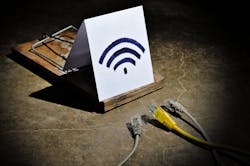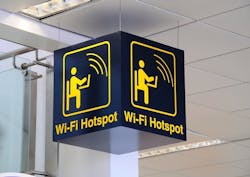10 Wi-Fi Predictions for 2024 and Beyond
Following the release of the WBA Annual Industry Report 2024, Tiago Rodrigues, CEO of the Wireless Broadband Alliance (WBA), revealed ten predictions for this year and beyond that he believes will change the way wireless technology is used by communities and businesses across the world, including improved connectivity, efficiencies and new consumer experiences.
10 Wi-Fi Predictions for 2024 and Beyond
1. In the future 10 Gbps speeds will be commonplace. Fiber broadband deployments will continue to expand in most developed and developing markets, creating a need for an upgrade of home Wi-Fi networks to pass on the increased bandwidth to the device, which will drive the rapid adoption of Wi-Fi 6E and Wi-Fi 7. The rapid adoption of Wi-Fi 6E/7 will also be driven by its ability to access additional spectrum in the 6GHz band as more countries open the band.
2. The capabilities of Wi-Fi 7 will drive immersive experiences and advance gaming and video content. A recent Bain & Company report forecasts that global revenue for video gaming could increase by another 50 percent over the next five years. In a sport where milliseconds count, networking equipment will be just as crucial to the game as the speed of the gaming rig. Wi-Fi 7 will be critical for speed and near-zero latency, and game developers will break new barriers with immersive experiences. Wi-Fi 7 client devices have already been released in 2023 with Qualcomm chipset with more to come in 2024.
3. OpenRoaming growth will continue and extend to integrate with private 5G and IoT networks in 2024, reaching a critical point of exponential growth by 2026 when tens of millions of hotspots will be enabled. Deployments of OpenRoaming (with Passpoint), continue to rise as more brands and identity providers recognize the value of the federation to enable seamless connectivity access across different networks.
4. Convergence will progress enabling access to private and/or public 5G services over Wi-Fi. We expect network executives will continue deploying Wi-Fi and cellular in the coming years, with Wi-Fi 6E/7 for indoor, on-campus, and fixed network situations and 5G/cellular for outdoor, off-campus, and mobile environments. Rather than competing with 5G over emerging high-performance use cases, the Wi-Fi community continues to work on coexistence with 5G, especially around identity management, authentication, and policy management.
5. NaaS (Network as a Service) will rise beyond early adopters (e.g. managed Wi-Fi in multi-apartment units) spreading quickly to traditional enterprises where networks provide cloud-first, software-defined, application-centric environments. NaaS is attracting customers because it accelerates and simplifies the deployment of devices in today’s shortened equipment replacement and improves security with the delivery of continuous security updates that prevent and reduce breaches and outages.
6. The role of AI (artificial intelligence) and ML (machine learning) cannot be overstated, with Adaptive AI set to explode on networks, from enabling Automated Frequency Coordination (AFC) to predicting network resourcing needs. AI will help enterprises and ISPs speed up troubleshooting; streamline monitoring; and proactively anticipate outages, equipment failures, and performance degradation.
7. Outdoor AFC will initially be successful in rural connectivity, in countries that have opened large portions of the 6GHz spectrum to Wi-Fi. We expect 6GHz low-power indoor (LP) devices with an average transmit power of 24 dBm to proliferate quickly for indoor applications such as residential mesh, indoor public venues, and high-density enterprise networks. We also expect 6GHz very low-power indoor (VPI) devices with 14 dBm maximum transmit power to be quickly adopted for short-range indoor applications such as AR/VR/XR, streaming, and gaming. These device classes do not require Automated Frequency Coordination (AFC) coordination with the incumbents.
8. New IoT technology will help unify connectivity across multiple home devices, transforming home users’ experience with IoT devices. Matter— a new industry standard launched in 2023 provides reliable, secure connectivity across multiple device manufacturers. Given the weight of players involved (e.g., Apple, Amazon, Google, Samsung SmartThings), we expect the adoption of Matter-certified products will be exponential in the next three years, validating Wi-Fi’s central role in the smart connected home and buildings.
9. Pilot projects and trials of TIP Open Wi-Fi will proliferate in developing countries and price-sensitive markets due to its cost-effectiveness and the benefits offered by an open disaggregated model. Well-established wireless local-area network (WLAN) vendors will continue working to make themselves more cost-effective in these markets through massive investment in machine learning and AI and an integrated Wi-Fi + 5G offering to enterprises.
10. Augmented and virtual reality will gain a larger share of our daily lives at home and work, but it will require indoor broadband networks to adapt with improvements in user interfaces and network capabilities to cater for larger group of users. According to Bloomberg, the metaverse’s economy is expected to generate $800 billion by 2025 and $2.5 trillion by 2030. Thus, the metaverse is the universe of the future. Major brands are making substantial investments in this technology.
“There has never been a more exciting time for Wi-Fi with technologies such as OpenRoaming more widely available than ever and addressing the challenges in areas including Guest Wi-Fi provision, IoT deployments and private cellular networks,” said Tiago Rodrigues, CEO of the Wireless Broadband Alliance. “The HaLow program is creating huge interest in low-power extended range Wi-Fi and we are looking forward to working with the Wi-Fi ecosystem to develop industry trials for Wi-Fi 7 during 2024.”
Read more about these trends in the WBA Annual Industry Report 2024.


